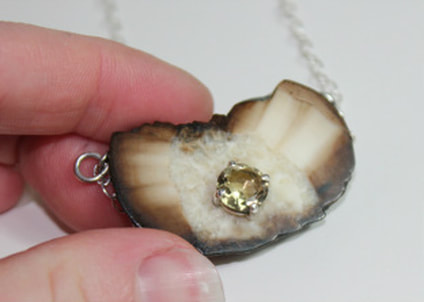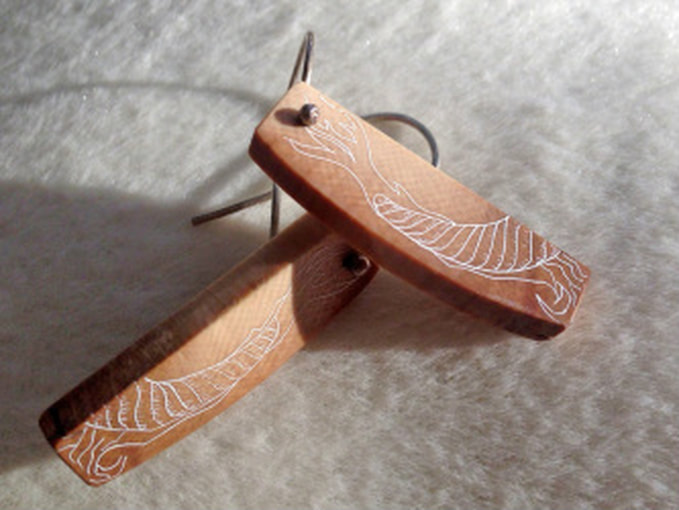What is Fossil Ivory?
|
Fossil ivory refers to ivory that has been in the earth for hundreds or thousands of years. The ivory has not quite turned into rock, but has taken the first step. Minerals from the soil have seeped into the ivory over time, imparting unique colors and visual textures. The result is that the "fossilized" ivory remains lightweight but gains fantastic browns, corals, tans—even blues and greens!
Fossil ivory, known also as "ancient ivory," comes from several different animals. I use wooly mammoth/mastodon and walrus ivory. |
Mammoth/mastodon ivory is at least 10,000 years old and does indeed come from those very large, furry (and extinct) ancestors of elephants. The material is smooth and creamy and often softer than fossil walrus, due to age. Fossil mammoth and mastodon ivory has a distinct crisscross pattern of fine lines which show the growth of the tusks. These lines are similar to the growth lines in elephant ivory but the angle of the cross-hatching is distinctly different, helping me ensure that the ivory I buy is indeed ancient. I check every piece to be certain. Because of its age, mammoth ivory is rare and sometimes more difficult to work with, but it yields lovely, lustrous results.
Fossil walrus ivory has a totally different story. This material can be several hundred to several thousand years old. Fossil walrus ivory has a unique look because walrus tusks are essentially big teeth, so they have an outer enamel layer and an inner pulp layer. The outer layer is smooth with little texture or variation (unless minerals have given it stripes!), but the inner layer is swirled like burled wood. The two layers often absorb minerals very differently, with striking results. Sometimes I get a few fossil walrus teeth. They’re only 1 to 2 inches (2.5 to 5 cm) long and exciting to cut because you never know what’s inside.
Fossil walrus ivory has a totally different story. This material can be several hundred to several thousand years old. Fossil walrus ivory has a unique look because walrus tusks are essentially big teeth, so they have an outer enamel layer and an inner pulp layer. The outer layer is smooth with little texture or variation (unless minerals have given it stripes!), but the inner layer is swirled like burled wood. The two layers often absorb minerals very differently, with striking results. Sometimes I get a few fossil walrus teeth. They’re only 1 to 2 inches (2.5 to 5 cm) long and exciting to cut because you never know what’s inside.
FAQs
Where do you get your fossil ivory?
Walrus and mammoth/mastodon fossil ivories are originally from Alaska and Russia, where they’re preserved in ice and snow. I get all of my fossil ivory in the form of scraps that are cast aside by other makers. Pieces which are too small or oddly shaped for them are just perfect for me. The best inspirations often come from the strangest end pieces and off-kilter slices.
Is that legal?!
Yep! No creatures were harmed in the gathering of fossil ivory, unless one of the humans digging it up stubbed his toe. The mammoths and mastodons have long been extinct. And to protect the current walrus population, fossil walrus ivory is a highly regulated material, sourced only from Alaska, and sold only within the US.
Is fossil ivory as hard as a rock?
It’s more like hardened wood, without a grain structure. Fossil ivory can be cut and shaped with basic hand tools, unlike true rocks which require special water-cooled equipment. While fossil ivory has fossil in the name, it’s technically “mineralized” - think of it as only part way to true fossil-hood.
How do I care for or clean fossil ivory jewelry?
Treat these pieces similar to pearls—put your perfume or lotion on before you put on your jewelry, store it away from harder items like metal and gemstones, and try not to get it wet. Take your fossil ivory ring off to wash your hands. Because fossil ivory is a porous and organic material, it can absorb liquids and chemicals or react to heat, so a little caution helps it live a few hundred more years!
If the metal around the fossil ivory tarnishes (turns black), use a polishing cloth to clean it. If you have a tarnish removing liquid/dip, you can use that on any chains or metal-only sections of the jewelry, but do not dip the fossil ivory. If you do get it wet, dry it thoroughly with a soft fabric (like a cotton T-shirt).
Ivory can be rubbed with a tiny bit of Renaissance Wax occasionally to create a light protective barrier. This isn’t usually necessary; I always wax pieces before selling them. Rings might benefit from a bit of wax annually, if you’re hard on your hands. Then again, I’ve never re-waxed anything I own and it’s doing great after a decade. If you’re unsure, feel free to contact me with questions any time.
Walrus and mammoth/mastodon fossil ivories are originally from Alaska and Russia, where they’re preserved in ice and snow. I get all of my fossil ivory in the form of scraps that are cast aside by other makers. Pieces which are too small or oddly shaped for them are just perfect for me. The best inspirations often come from the strangest end pieces and off-kilter slices.
Is that legal?!
Yep! No creatures were harmed in the gathering of fossil ivory, unless one of the humans digging it up stubbed his toe. The mammoths and mastodons have long been extinct. And to protect the current walrus population, fossil walrus ivory is a highly regulated material, sourced only from Alaska, and sold only within the US.
Is fossil ivory as hard as a rock?
It’s more like hardened wood, without a grain structure. Fossil ivory can be cut and shaped with basic hand tools, unlike true rocks which require special water-cooled equipment. While fossil ivory has fossil in the name, it’s technically “mineralized” - think of it as only part way to true fossil-hood.
How do I care for or clean fossil ivory jewelry?
Treat these pieces similar to pearls—put your perfume or lotion on before you put on your jewelry, store it away from harder items like metal and gemstones, and try not to get it wet. Take your fossil ivory ring off to wash your hands. Because fossil ivory is a porous and organic material, it can absorb liquids and chemicals or react to heat, so a little caution helps it live a few hundred more years!
If the metal around the fossil ivory tarnishes (turns black), use a polishing cloth to clean it. If you have a tarnish removing liquid/dip, you can use that on any chains or metal-only sections of the jewelry, but do not dip the fossil ivory. If you do get it wet, dry it thoroughly with a soft fabric (like a cotton T-shirt).
Ivory can be rubbed with a tiny bit of Renaissance Wax occasionally to create a light protective barrier. This isn’t usually necessary; I always wax pieces before selling them. Rings might benefit from a bit of wax annually, if you’re hard on your hands. Then again, I’ve never re-waxed anything I own and it’s doing great after a decade. If you’re unsure, feel free to contact me with questions any time.
|
Customize
Make it your own. |
Contact Me
Ask a question. |
Bonedance Jewelry
Simple, elegant handmade jewelry & one of a kind materials |


